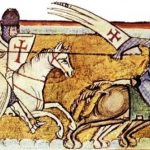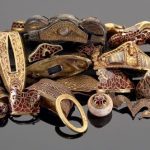 Technology
Technology  Technology
Technology  Humans
Humans 10 Everyday Human Behaviors That Are Actually Survival Instincts
 Animals
Animals 10 Animals That Humiliated and Harmed Historical Leaders
 History
History 10 Most Influential Protests in Modern History
 Creepy
Creepy 10 More Representations of Death from Myth, Legend, and Folktale
 Technology
Technology 10 Scientific Breakthroughs of 2025 That’ll Change Everything
 Our World
Our World 10 Ways Icelandic Culture Makes Other Countries Look Boring
 Misconceptions
Misconceptions 10 Common Misconceptions About the Victorian Era
 Mysteries
Mysteries 10 Strange Unexplained Mysteries of 2025
 Miscellaneous
Miscellaneous 10 of History’s Most Bell-Ringing Finishing Moves
 Technology
Technology Top 10 Everyday Tech Buzzwords That Hide a Darker Past
 Humans
Humans 10 Everyday Human Behaviors That Are Actually Survival Instincts
 Animals
Animals 10 Animals That Humiliated and Harmed Historical Leaders
Who's Behind Listverse?

Jamie Frater
Head Editor
Jamie founded Listverse due to an insatiable desire to share fascinating, obscure, and bizarre facts. He has been a guest speaker on numerous national radio and television stations and is a five time published author.
More About Us History
History 10 Most Influential Protests in Modern History
 Creepy
Creepy 10 More Representations of Death from Myth, Legend, and Folktale
 Technology
Technology 10 Scientific Breakthroughs of 2025 That’ll Change Everything
 Our World
Our World 10 Ways Icelandic Culture Makes Other Countries Look Boring
 Misconceptions
Misconceptions 10 Common Misconceptions About the Victorian Era
 Mysteries
Mysteries 10 Strange Unexplained Mysteries of 2025
 Miscellaneous
Miscellaneous 10 of History’s Most Bell-Ringing Finishing Moves
10 Fascinating Glimpses into Medieval Crime Investigation
Ever since the publication of Umberto Eco’s The Name of the Rose, a murder mystery set in the Middle Ages, the medieval detective story has grown in popularity. There were no detectives in our modern sense during the Middle Ages, of course.
However, the idea of the protagonist relying solely on observation, experience, and knowledge of the natural world fascinates readers accustomed to crime-solving through fingerprints, ballistics, DNA, trace evidence, and other marvels of modern forensics. But what was crime investigation in the Middle Ages really like?
Related: Top 10 Victorian Era Crime Solving Techniques
10 A Violent Age
Today, we describe a particularly gruesome and vicious attack as “going medieval” on someone. Though it may be argued that the Middle Ages is no more brutal than contemporary times, we are still staggered by the amount of daily Game of Thrones-level violence in medieval society, even in times of peace.
It has been calculated that homicide levels in England during the period were 10 times what it is today. Records suggest that half of all murders resulted from simple arguments. Only some Italian city-states had salaried law enforcers. As we might expect from a society with no police force, the majority of murderers simply fled the scene and were never caught. But surprisingly, we encounter little of modern America’s scourge, the serial killer. Of these, only Joan of Arc’s lieutenant Gilles de Rais, who kidnapped, sexually abused, and murdered over 100 boys, emerges prominently on record.
The Church, which should have been a refuge from this violent world, itself sanctioned torture and execution for heretics and taught St. Augustine’s rationale for “just war”—holy violence to enforce moral conformity. Extended to individuals and families, it was a veritable license to kill. We read of a priest preaching approvingly of a man killing his adulterous wife and her lover when he caught them in the act. In Iceland, revenge killing was legal as long as it was inflicted only on the offender. Italy struggled to regulate personal vendettas.
Killers who did get caught often went unpunished. Claims of self-defense and homicides born out of hot-blooded passion were tickets to acquittal. Some prisoners simply bribed the authorities, and others took up religious orders to escape secular courts. In all, only 12 to 20 percent of homicide cases ended in conviction. Medieval society was full of murderers roaming about free.[1]
9 Compurgation
In the early Middle Ages, finding a criminal relied more on superstition than fact-based investigation. The belief that God punishes the guilty and protects the innocent gave rise to several procedures to uncover God’s judgment. Someone accused of a crime could gather a number of people to swear to their innocence in a method called compurgation or trial by oath.
The number of oath-takers varied with the seriousness of the crime. Germanic Queen Uta, accused of adultery in 899, was exonerated by the oaths of 82 knights confirming her chastity; a Welshman charged with poisoning, on the other hand, was required to present 600 compurgators for his defense. Most of us don’t even have half that number as “friends” on Facebook. Compurgation in criminal matters persisted until the 16th century.
If one could not find any compurgator on one’s behalf, he could be tried by ordeal, which was the medieval version of our lie detector. The most common were the ordeals of fire and water. In the first instance, a suspect was required to carry a red-hot iron with his bare hands for 9 feet (3 meters). If the wound healed within three days, he was innocent. If it festered, he was guilty. In the ordeal by water, the accused was thrown into a river. If he sank, it was a sign of God’s acceptance; if he floated, it meant the water—and God—was rejecting him as guilty.
Trials by ordeal did not sit well with the Church, which felt it was inappropriate to ask God for a “miracle on demand.” In 1215, it forbade priests from blessing the hot iron and water used in the trials, rendering any result invalid. Through a decree by King Henry III in 1219, the jury, which before this decided who should undergo the ordeal, now became an investigative fact-finding body that determined guilt through evidence. Medieval justice had made a great leap forward.[2]
8 The Law of Torture
It is common knowledge that torture was used in the Middle Ages to elicit confessions. What is less well-known is that judicial torture had rules and procedures to follow to ensure that a suspect’s admission of guilt was reliable, as it was understood even then that the accused would say anything just to stop the torture. When trials by ordeal were banned in 1215, jurists searched for a way to replace what they imagined to be the absolute proof offered by the tests with adjudication by fallible human judges instead of God.
The system devised required the testimony of two unimpeachable eyewitnesses for conviction. Only this, or the accused’s voluntary confession, could secure a conviction. Circumstantial evidence was not enough: it didn’t matter if the suspect was seen fleeing the crime scene or if the murder weapon was found in his possession. Only if he was seen actually killing the victim could he be judged guilty.
In the desire for absolute certainty, jurists had set the bar too high. As one might expect, this law made it childishly simple to get away with murder. In cases of clandestine crimes, voluntary confession was the only way to get a conviction. But judges wanted torture to be applied only to those most likely guilty.
To obtain probable cause for torture, there must be “half-proof” against a suspect, say, one eyewitness, or finding both the murder weapon (1/4 proof) and loot belonging to the victim (1/4 proof) in the suspect’s possession. Confessions obtained by torture were considered “voluntary” only if the accused repeated it in court. But threats of another round of torture upon recantation made such confessions unreliable. To safeguard against this, confessions were required to be independently corroborated by other evidence.
It is simply a myth that torture was used willy-nilly and without restraint in the Middle Ages. To say, as historian Michel Foucault did, that medieval Europe was “the country of tortures, dotted with wheels, gibbets, gallows, [and] pillories” might be somewhat excessive. Nevertheless, as more humane methods of investigation developed, judicial torture gradually fell out of favor and finally ended in the 18th century.[3]
7 Ordeal of the Bier
A method of ferreting out a murderer that survived beyond the Middle Ages to at least the late 17th century was cruentation or the Ordeal of the Bier. Ancients believed that the recently dead were somehow still conscious and could display indignation in the presence of their murderer. It was thought that the touch of the killer would cause the corpse’s blood to flow.
In the Middle Ages, a slain victim was laid naked on his back, and the suspect made to approach the body, calling out its name repeatedly. The suspect circled the body twice or thrice, lightly stroking its wounds. If fresh bleeding appeared, or if the mouth foamed, or if the body moved, the suspect was guilty. Sometimes, if no suspect was to be found, the entire community was required to pass by the body. It was hard to overcome such superstition, and cruentation persisted as late as 1688 when it was accepted as evidence by an Edinburgh High Court.
It has been suggested that the modern practice of viewing the body originated in the Ordeal of the Bier.[4]
6 Hue and Cry
Calling the cops was not an option when a body was found. In England, the person who discovered the corpse was called the “First Finder.” It was their responsibility to raise the “hue and cry,” as in scream bloody murder or some such alarm to call the neighbors. In a close-knit community where everyone knew each other and presumably their movements, it was likely a suspect might be identified forthwith. A First Finder who chose not to be involved by backing surreptitiously out of the scene risked being fined if found out.
The neighbors then took it upon themselves to arrest the suspect and look for evidence of guilt. If he fled, they must pursue him. If he resisted arrest, they were permitted to kill him on the spot. If he submitted, he was bound for trial, and a jury was elected from among the people who knew him. It was charged to further investigate the case if evidence was absent or insufficient.[5]
5 Sheriffs and Coroners
The officials responsible for law enforcement were the sheriff and the coroner. The sheriff (shire reeve) was the closest thing medieval England had to a police detective. He investigated serious crimes and had the authority to form a “posse comitatus” to hunt down fugitives. The posse comitatus was a group of local men over 15 who were conscripted by the sheriff, sometimes against their will. The sheriff worked with the coroner (from the Latin “corona,” meaning crown, referring to an employee of the king) who endeavored to find the cause of any suspicious or violent death. (Link 15)
Assisting the coroner was a jury of 12 to 24 men from the neighborhood. In the presence of the dead victim at the scene of the crime, they questioned potential eyewitnesses and gathered clues and evidence. The jury’s findings were recorded on coroner’s rolls. These texts specified the time and location of the homicide, the names of people involved, the events leading up to the crime, the weapon used, the nature and dimensions of the wound, and what happened to the culprit. The preliminary verdict made by the coroner’s jury was crucial in informing the trial jury’s vote when the case came to court. [6]
4 Autopsies
The first recorded autopsy was one performed on the assassinated Julius Caesar in 44 BC by Antistius, who singled out among 23 stab wounds the one through Caesar’s chest as the fatal blow. It had ruptured the aorta.
English coroners were handicapped by their inability to perform autopsies. They were not physicians themselves and had to consult outside experts to help them assess an unnatural death. But even these could not just open up a body. Northern Europeans, including the English, had peculiar notions about the dead. They believed the soul separated slowly from the body, in sync with the latter’s decomposition. Autopsies were taboo.
On the Continent, especially in Italy, where the soul was believed to separate immediately from the corpse, autopsies were regularly performed by medical professionals called upon to investigate a suspicious death. The first explicitly forensic—for legal as opposed to purely academic purposes—autopsy was carried out by Bartolomeo Varignana in 1302 upon the request of a Bolognese magistrate. Reliance by Continental courts on the expert testimony of professionals put their forensic science way ahead of England’s.[7]
3 The Knight Detective
One night in November 1407, Louis, Duc de Orleans and brother of French King Charles VI, was ambushed by masked assassins on a Paris street and hacked to death. The job of finding the killers fell on the king’s chief law enforcer, the Provost of Paris Guillaume de Tignonville. Though a knight by profession, de Tignonville just may be one of the first true detectives.
De Tignonville rushed to the crime scene, ordering all city gates closed to prevent the assassins’ escape. He examined the horribly mutilated body and had officers investigate a nearby house the killers had apparently used as a hideout. Over the course of several days, he and his men interviewed dozens of witnesses as they tried to piece together what happened. The broker who rented out the house to the murderers and vendors who sold them goods and supplies provided essential information.
Soon, a picture of a far-flung conspiracy slowly emerged, and de Tignonville courageously dared some of the most powerful men in France to open up their chateaux to allow his men to search for evidence. The conspirators were finally unmasked, including a member of the royal family who had lamented at Louis’s funeral, “Never was there a more treacherous murder!”
What is remarkable about this case is that de Tignonville solved it without resorting to the usual medieval methods of torture and forced confessions. Instead, he relied on collecting physical evidence and interviewing witnesses, the very same procedures still being used by modern police. Guillaume de Tignonville was a sleuth ahead of his time.[8]
2 The Father of Forensic Science
While European law enforcement floundered in ignorance and superstition, half the world away in Sung Dynasty China, a physician and judge named Song Ci published a manual in the 13th century to guide coroners in assessing suspicious and violent deaths. The work The Washing Away of Wrongs addresses such concerns as the cause and time of death, types of injuries, and rates of decomposition.
Here are some of Song’s observations:
Death by suffocation: “From the mouth and nose, a clear bloody fluid will flow. All over the face, there will be subcutaneous blood of a reddish-black color, the bowels will protrude, and the insides of the clothing will be soaked in urine.”
Beheading: “Again, when the head of a living victim is cut off, the muscles shrink back and stiffen. But if the head is cut off a corpse, the neck will be long. There will be no contraction.”
Burning: “When a living person is burned to death, there will be sooty ashes in the mouth and nose of the corpse… If the burning occurred after death… there will be no sooty ash in the mouth or nose.”
Song even had a version of our Luminol: “On the cleaned spot where the corpse has been, sprinkle a thick decoction of rice cooked in vinegar and wine. If the victim was murdered there, the spot where blood soaked into the ground will be fresh red in color.” To discover latent injuries, he recommended covering the body with mashed white plums. Like modern forensic pathologists, Song used diagrams of the human body to pinpoint the injuries sustained.
While Song Ci’s manual still accepted some superstitious folk beliefs as fact, its methods nevertheless guided Chinese law enforcement for centuries. And Song can be rightly called the Father of Modern Forensics.[9]
1 The Case of the Bloody Sickle
In 1235, Song was summoned to investigate the murder of a peasant in a rural village. He had been found hacked to death by the roadside. By testing different types of blades on an animal carcass and comparing the cuts to the victim’s wounds, Song concluded that the murder weapon was a sickle. This indicated that the killer most likely was a fellow peasant.
Song ordered the ten or so villagers who owned sickles to lay them out in the hot afternoon sun. After a while, flies began to buzz over one particular sickle. It appeared clean, but the flies were attracted to the residual smell and traces of blood and tissue the human eye and nose could barely detect. Faced with this overwhelming evidence, the owner of the sickle confessed.
This is the first murder case ever solved by forensic entomology. In his manual, Song also describes how to tell the time of death from the appearance of maggots on the body. Hard to believe this was all nearly 800 years ago.[10]








